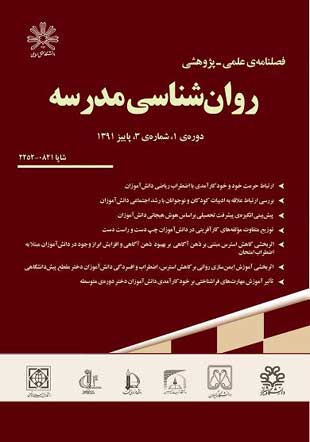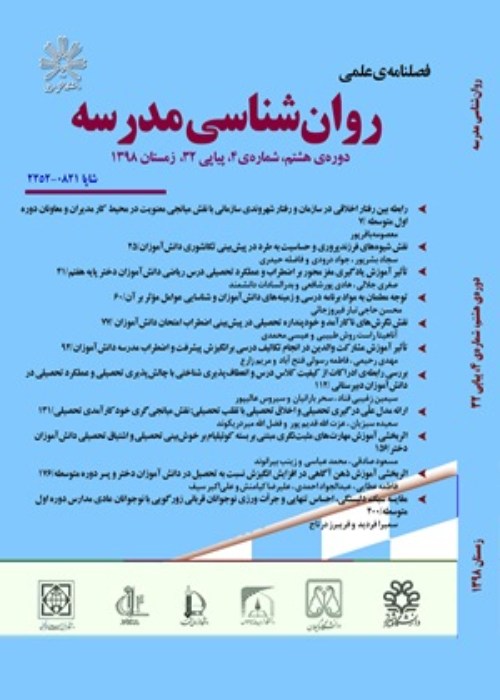فهرست مطالب

فصلنامه روان شناسی مدرسه
پیاپی 3 (پاییز 1391)
- تاریخ انتشار: 1391/08/13
- تعداد عناوین: 7
-
-
Page 6The aim of the present research was to determine the relationship of self-esteem and selfefficacy to mathematical anxiety in students. This is a correlation study. The population of this study includes all second-grade high school students of Ardabil enrolled in the 2009-2010 academic year. The research sample consisted of 480 male and female students who were selected through multistage random sampling. To collect data, a mathematics anxiety rating scale, selfesteem scale and self-efficacy scale were used. The results of Pearson’s correlation analysis showed that self-esteem and self-efficacy are positively associated with mathematical anxiety in students (p<0/001). Multiple regression analysis showed cognitive selfesteem, academic self-efficacy and emotional selfefficacy to be the best predictors mathematical anxiety in students. Findings also revealed a significant difference between the mathematics anxiety of male and female students (p<0/01). Significant differences were also noted in the mathematical anxiety of students majoring in humanities and those majoring in science or mathematics (p<0/001).Keywords: self, esteem, self, efficacy, mathematical anxiety
-
Page 27The main goal of this study was to determine the relationship between interest in literature and social development of students. The population of this study comprised all male and female students enrolled in the fifth, sixth and seventh grades in educational zones 1 and 2 in Ardabil during the 2010-2011 academic year. A sample of 617 individuals was selected using a multistage randomized cluster sampling procedure. In keeping with the aims of the study, a correlational research method was used. The tools used in this study included a researcher constructed questionnaire, a test of social development and Raven’s Progressive Matrices. Multiple regression analysis showed that books, sports, science, and history magazines contribute positively, while poetry and art books contribute negatively to the prediction of social development. In this study, books and sports magazines played a greater role in the prediction of student's social development. Gender and grade differences in social development were also explored.Keywords: interest in literature, social development, book reading
-
Page 49The aim of this research was to understand the relationship of emotional intelligence and its dimensions (self-awareness, selfmanagement, social awareness and relationship management) to achievement motivation. The statistical population included all female first grade high school students studying in Karaj city. A sample of 60 students was selected by multi-stage random cluster sampling procedure. All participants completed the Achievement Motivation-Denver Youth Survey and Bradberry-Greaves Emotional Intelligence test. Results showed a significant positive relationship between achievement motivation and emotional intelligence. Global emotional intelligence as well as its components, self-awareness, self- management,and relationship management correlated positively with achievement motivation. But social awareness was not found to be associated with achievement motivation. The results showed that adolescents with high emotional intelligence hold more realistic perceptions in interpersonal relationships and this ability probably helps them develop achievement motivation. Higher achievement motivation may help enhance feelings of self-efficacy as well as academic motivation.Keywords: emotional intelligence, achievement motivation, students
-
Page 63
The present study aimed at exploring the relationship between entrepreneurial traits and handedness among school students in Tehran. This was a causal-comparative study and data were collected using records and questionnaires (Entrepreneurship Character Questionnaire and Edinburg Handedness Inventory). In this study, the statistical population comprised all students from the 22 educational zones in Tehran. A sample of 1200 students was selected by a random cluster sampling procedure and after the distribution of questionnaires, a total of 1101 questionnaires were returned. In order to analyze the obtained data, apart from descriptive techniques such as means, standard deviations and graphs, multivariate ana;ysis of variance and oneway analysis of variance were used, Findings revealed a significant relationship between the entrepreneurial character traits of riskability and entrepreneurship success and handedness, withgreater riskability among left- handed participants than in right-handed participants. However, the entrepreneurship success seeking trait was found to be greater in right-handed participants.
Keywords: entrepreneurial traits, handedness, students -
Page 82The aim of the present research was to examine the efficacy of mindfulness based stress reduction on the mindfulness and assertiveness of students with test anxiety. The sample consisted of 45 subjects with test anxiety randomly selected from third grade guidance school girls and boys of Nowshahr city. The subjects were assigned randomly to experimental and control groups. The experimental group received training in minfulness based stress reduction. The instruments employed in this research were test anxiety inventory, mindfulness inventory and assertiveness scale. Multivariate analysis of variance showed significant differences between the group receiving training in mindfulness and the control group on the variables of mindfulness, assertiveness and test anxiety. Mindfulness based stress reduction affected the mindfulness, assertiveness and test anxiety of the students.Keywords: stress reduction, mindfulness, assertion, test anxiety
-
Page 101The aim of present study was to examine the effectiveness of stress inoculation training in decreasing stress, anxiety and depression of preuniversity girl students. An experimental research method was used. To attain the research objective, a pre-university school was randomly selected and the Lewinda inventory was administered to all students of that school. Out of those students scoring above 27, forty were randomly selected and assigned to experimental and control groups. The 20 subjects in the experimental group were given stress inoculation training. Data were collected using the Lewinda stress, anxiety and depression inventory. Results of repeated measures analysis of variance showed that stress inoculation training was effective in reducing the stress, anxiety and depression of pre-university girl students. From these results it can be concluded that the use of stress inoculation training can significantly decrease stress, anxiety and depression of pre-university girlstudents. These results have important implications for the enhancement of the mental health of students.Keywords: stress inoculation training, stress, anxiety depression
-
Page 118The main purpose of this study was to determine the impact of metacognition skills instruction on secondary school girl students’ selfefficacy. A quasi experimental research method was used. The statistical population (N= 520) comprised all grade three secondary school girl students studying Humanities in Hamedan city. Using a cluster sampling method, two classes and 70 subjects were selected as the study sample. The instrument used for data collection was the Sherer self-efficacy assesment scale. The validity of the questionnaire has been reported as acceptable. The reliability of the instrument computed through Cronbach’s alpha was 0.81. Data were analyzed using descriptive indices, such as the frequency, mean, standard deviation, and inferential tests such as the independent t-test, analysis of covariance and one-way analysis of variance. Findings show that goal centring, goal penetration, internal motivation, problem solving skills and self evalution of the students who recieved metacognition instruction were greater than those of students not receiving such instruction.Keywords: metacognition skills, self, efficacy, girl students, secondary school


